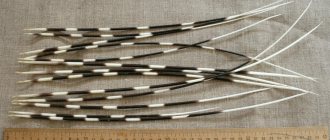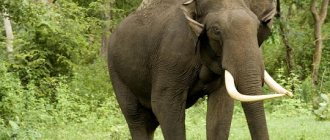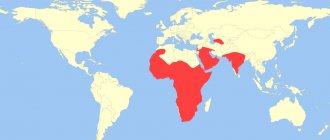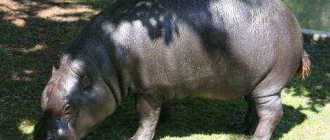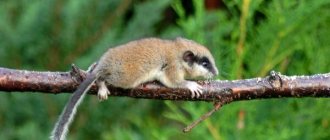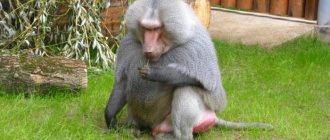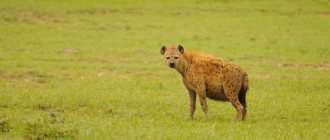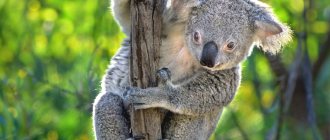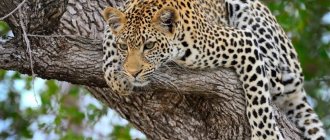Primates from the genus Tarsier were described in the 18th century. Three types are currently known for them. The name of the animal is due to the fact that its hind limbs are always longer than its forelimbs.
Description of the tarsier
Description of the tarsier photo
– Advertisement –
Tarsier (lat. Tarsius) is a small animal, 9-16 cm long. The tail is bare, decorated with a tassel at the tip, its length is 13-28 cm. The weight of adult individuals ranges from 80 to 160 g. The hind limbs are long, the head large, round in shape, located vertically in relation to the body, and the angle of its possible rotation is about 360°. The long fingers of tarsiers are thickened at the tips - they have peculiar suction cups that help them climb trees. Bare ears are round in shape. Tarsiers have very well developed hearing. It is also the only species among all primates that “communicates” using ultrasound. Animals hear sounds at frequencies up to 90 kHz and scream at frequencies of 70 kHz.
The fur is soft, brownish or grayish in color. The most noticeable and recognizable feature of the tarsier is its large eyes, the diameter of which reaches 16 mm. They look straight ahead, unlike many other primates. If you project the size of a tarsier's eye onto a human body, it will be equal to an apple. And the yellow eyes of this species have the ability to glow in the dark.
Records
Philippine tarsier
sometimes called
the smallest primate
. This is not true, the smallest primates are mouse lemurs from the island of Madagascar.
He is also called the smallest monkey in the world
.
This statement is closer to the truth if we remember that tarsiers
were classified as a suborder
of dry-nosed monkeys
.
But it remains controversial, because tarsiers
continue to be considered at the same time
as prosimians
, without being classified as “
real monkeys
”.
Among the “real” ones, the smallest is considered to be one of the marmosets - marmosets, whose sizes are comparable, but still slightly larger than those of the tarsier
.
The tarsier
is said to have the largest eyes
in relation to head and body size of any mammal. It's hard to say for sure, but this statement is very likely to be true. At least the Guinness Book of Records is sure of this.
In tarsiers
the slowest growing embryos among mammals. About 6 months pass before birth, and during this time the embryo gains weight of only 23 grams (!).
Tarsier eye weight
more brain weight.
Feeding features of the tarsier
Feeding features of the tarsier photo
The basis of the tarsier's diet is insects, in addition, they can feed on small vertebrates. Among the primates, the tarsier, the photo you can see above, is the only species that eats exclusively animal products. The tarsier stuns its prey by jumping. He eats 10% of his weight in food per day.
Sifaka - the most jumping lemur
Verreaux's sifaka or crested indri (Propithecus verreauxi) lives in the northern part of the island. It is also called the dancing lemur, because it moves along the ground by jumping on its hind legs, with its arms spread wide. From the outside it seems as if he is performing some kind of funny dance. In general, sifakas are absolute champions in jumping and flying. They can easily jump onto the second floor of a residential building!
Sifaka is popularly called a sun worshiper. When the sun rises, he sits on a tree branch, raises his hands and freezes. It seems as if the animal is praying to its gods. In fact, lemurs bask in the sun specifically to warm their wrists. In this place there are glands that secrete a special lubricant. Hanging on a tree, the animal leaves its scent on the bark, which makes it clear to strangers whose territory it is.
Common types of tarsier
Diana tarsier (Tarsius dentatus)
Diana tarsier (Tarsius dentatus) photo
A nocturnal animal that is endemic to central Sulawesi (Indonesia). The body is up to 12 cm long, the tail is about 22 cm long. The species is distributed in tropical rain forests, primary and secondary forests, and in mangroves. Lives in groups of 2-7 individuals. It has good ability to jump and climb trees. The diet consists of animal foods, insects and small vertebrates.
Pygmy tarsier (Tarsius pumilus)
Pygmy tarsier (Tarsius pumilus) photo
This species lives in the central regions of the island of Sulawesi in Indonesia. Previously, scientists believed that the pygmy tarsier became extinct at the beginning of the 20th century, but at the beginning of the 21st century the animal was discovered again. Two males and females captured later had special sensors attached to them to track their movements.
This species is the smallest among its relatives. The length of the dwarf tarsier is from 95 to 105 mm, weight does not exceed 57 g. The ears are small, the fur is light, brownish-red. The tail is covered with thick hair and is 135-275 mm long. The eyes are large, approximately 16 mm in diameter. All limbs of the animal have claws.
Eastern tarsier (Tarsius tarsier)
Eastern tarsier (Tarsius tarsier) photo
The primate's eyes are very large. The head is round, the neck is short, the muzzle is flat. The ears are thin, without hair. The fur is soft, silky, gray or yellowish-gray. The belly and breast are lighter than the back. The tail is long, decorated at the tip with a tassel. The forelimbs are short, the hind limbs are long. The fingers are long and thin, the pads on them are flattened. The body length is 9.5-14 cm, the tail length is 20-26 cm. The weight of males is in the range of 118-130 g, females weigh from 102 to 114 g.
The eastern tarsier is common in Indonesia, Sulawesi and other islands. The animal lives in both primary and secondary forests, and in mangroves, bamboo groves, and bushes. Sometimes found in gardens.
The species is considered vulnerable, since the population size and its habitat have decreased significantly in recent years due to active human activity and a reduction in habitat for the animal.
Classification
About tarsiers
One thing can be said with confidence - these are, of course,
primates
, i.e. they belong to the same biological order as
humans
,
monkeys
and
prosimians
.
Dolgopyatov
often called both "lemurs" and "monkeys".
Which of the names is correct? Previously, scientists distinguished among primates prosimians
(the most famous representatives are
lemurs
) and “
true monkeys
.”
Tarsiers of
both, they are like a transitional link from prosimians to monkeys, the Great Soviet Encyclopedia says on this matter:
Moreover, some features (the structure of the teeth or intestines) are not characteristic of modern primates at all, i.e., judging by them, tarsiers
older than prosimians.
For a long time, tarsiers were classified as “underdeveloped” prosimians
, they were very similar in appearance and habits to some
lemurs
from the island of
Madagascar
. But this classification is already outdated.
Now among primates, wet-nosed monkeys
(which included almost all prosimians -
lemurs
and
lorises
) and
dry-nosed monkeys
(which included
monkeys
and
humans
).
So the tarsiers
have now been “promoted” and classified as more developed
dry-nosed monkeys
.
That is, now the question “ lemur or monkey
“We can confidently answer that
the
tarsier was never a lemur, but
a monkey
(with the caveat that in the “old” classification it remained
a prosimian
).
Who is considered a tarsier
- the question of the boundaries of biological systematics is an open and very complex question.
It would be most accurate to say that tarsiers
are
tarsiers
, not monkeys or lemurs (or both monkeys and prosimians at once), animals that break conventions.
But, nevertheless, we present the complete scientific classification of the Philippine tarsier in the Linnaean hierarchy:
| Rank | Name | Latin name | Note |
| view | Philippine tarsier | Tarsius syrichta | one of at least three species in the genus |
| genus | Tarsiers | Tarsius | the only genus in the family |
| family | Tarsier | Tarsiiformes | one of three families in the suborder |
| suborder | Dry-nosed monkeys | Haplorhini | |
| squad | Primates | Primates | |
| infraclass | Placental | Placentalia | |
| subclass | Viviparous mammals (true animals) | Theria | |
| Class | Mammals | Mammalia | |
| superclass | Quadrupeds | Tetrapoda | |
| group (infratype) | Ghostostomes | Gnathostomata | |
| subtype | Vertebrates | Vertebrata | |
| type | Chordata | Chordata | |
| subsection (supertype) | Deuterostomes | Deuterostomia | |
| chapter | Bilateral (Bilaterally symmetrical) | Bilateria | |
| sub-kingdom | Eumetazoans (true multicellular organisms) | Eumetazoa | |
| kingdom | Animals | Animalia | |
| superkingdom | Eukaryotes (Nuclear) | Eukaryota |
Speaking about theories of kinship and origin of species, it is impossible to ignore the 1916 hypothesis proposed by Professor Frederick Wood Jones
(
Frederic Wood Jones
, 1879-1954), according to which man did not descend from apes, but from ancient
tarsiers
, and apes are closer to lower apes than to humans.
“ tarsial hypothesis
” (from the Latin name of the animals -
Tarsius
) is based on the following features:
- vertical position of the body when moving along a horizontal surface (could be the basis of human upright posture)
- The body proportions of the tarsier (short arms and long legs) are close to those of humans (all apes have long arms and short legs)
- the nature of the arrangement of hair currents (direction of hair) in tarsier and humans are similar (in monkeys they are significantly different)
- shortened facial part of the skull
- there are no bones in the penis and clitoris
- proximity of the structure of the collarbones and some muscles
- etc.
Modern scientists completely reject the " tarsial theory"
“, but it is not excluded that the monkeys of the Old and New Worlds (independently) originated from the primitive
tarsiers
of the Eocene era, and among the former, man appeared.
That is, the tarsier
remains among our ancestors.
Tarsier behavior
Tarsier behavior photo
Tarsiers lead an active nocturnal lifestyle. For life, they choose forest trees, in the dense crowns of which they can safely hide during the day. The tarsier is able to move deftly through trees, its long hind legs allow it to jump several meters, throwing its hind limbs back, as do frogs or grasshoppers. The tail is used as a balancer.
Tarsiers generally lead a solitary life; in their natural habitat, individual individuals are usually separated by kilometers, and they guard their territory extremely jealously. Females and males in nature can be seen during the full moon in December-January, that is, during the period when mating season occurs. It is interesting that in the territory of artificially created reserves, tarsiers also live in groups.
Security
Tarsiers
protected by both international and local legislation, since 1986 this species has been assigned the status of “
endangered
”.
Among other things, the purchase and sale of tarsiers
.
Tourists need to pay attention to this: the animals are really very cute, not shy, and the desire to have a tarsier
as a pet is quite understandable.
However, by purchasing an animal, you violate strict laws regarding punishment and endanger the life of the tarsier
: keeping it at home is extremely difficult (take, for example, an uninterrupted supply of insects).
Soft toys that reproduce tarsiers
in natural scale.
Steps are currently being taken to preserve and restore the tarsier's
.
In 1997, the Philippine Tarsier Foundation
(Philippine Tarsier Foundation Inc., www.tarsierfoundation.org).
The Foundation acquired an area of 7.4 hectares in the department of Corella in the province of Bohol, where the Tarsier Center
.
tarsiers
are kept behind a high fence at the Center ; the animals are fed, reproduced, and shown to visitors.
Tarsiers
are free to leave the territory of the Center, which some of them do at night, climbing over the fence into the neighboring forest, returning in the morning.
The question is being raised about purchasing an additional 20 hectares to expand the protective zone and further limiting tourists’ access to the animals.
Tarsier Reproduction
Reproduction of the tarsier photo
The pregnancy of the female tarsier is quite long (about six months), the weight of newborn babies is 25-27 g, they are sighted, and the grasping reflex is strongly developed. At first, the baby clings to the mother's stomach, but she can also carry it in her teeth, holding it by the scruff of the neck. From the end of the second month of life, the little tarsier switches from milk feeding to meat food. Young tarsiers become sexually mature at 1 year of age. An age of 13 years has been recorded for the long-lived tarsier in captivity.
Lifestyle
The tarsier is a nocturnal animal and prefers to rest during the day. Usually sits on a branch of a tree or bush at a height of 2 m from the ground. Each individual has its own small territory - about 4 hectares of forest for females and about 6 hectares for males. The territory of one male may overlap with the territories of several females. He has excellent hearing: he can distinguish even the slightest rustles. Average life expectancy is 10 years.
The Philippine tarsier reaches sexual maturity at one year of age. The breeding season lasts from April to May, and the pregnancy lasts six months. The baby weighs about 25 g and is born with thick dark hair and open eyes. It is well prepared for life from the moment of birth; its grasping reflex allows it to attach itself to branches. Clings tightly to the mother and follows her everywhere, or she carries the baby in her mouth. After seven weeks of milk feeding, he begins to try adult food.
The main diet consists of insects and spiders. It also hunts small lizards, reptiles and amphibians. The main threats to the species are domestic cats and birds of prey, such as owls. Maximum lifespan in captivity is 24 months
Natural enemies of the tarsier
Natural enemies of the tarsier photo
The main threat to the tarsier population is the destruction of its living environment. The animal is also hunted for meat.
Taming tarsiers, as a rule, fails and ends in the death of the animal. The tarsier cannot get used to captivity, tries to escape and often breaks its head on the cage.
Habitat
Tarsiers live in the Philippine Islands. They love the tropics and dense vegetation. They prefer to be under the shelter of branched trees, tall grass, among bamboo shoots or in bushes. If necessary, they descend to the ground quickly and are also able to climb trees just as quickly.
The animals discussed most often lead a solitary lifestyle. They rarely meet each other when they cross other people's territories. One male can occupy a territory of about 6.45 hectares, and a female - about 2.45 hectares. With all this, the density of Philippine tarsiers per 100 hectares is about 16 males and 40 females. In 24 hours, the animal is able to cover up to 1.5 km of forest plantations, thus bypassing its property.
Interesting facts about the tarsier:
Interesting facts about the tarsier photo
- Tarsiers are widely represented in the ancient mythology and superstitions of the people of Indonesia. They believed that the head of this primate was not attached to its body (due to the fact that it rotates almost 360°), and they were afraid of meeting it, believing that the same fate awaited a person in this case.
- In the Philippines, the tarsier was considered a pet of the forest spirits.
Tarsier and man
Because of its unusual appearance, many would like to tame this tiny animal. Those who had such an opportunity tried to do this and became convinced that raising a personal pet from a baby is almost impossible, since they are wild animals. Small animals placed in a cage are trying to get out, and many have broken their heads, hitting the walls and trying to escape. Those lucky few who have adopted this primate noticed how diligently their animals fight insects - cockroaches and spiders. It is interesting to watch the animal when it starts to play. His muscles on his face create funny grimaces.
Basic information:
- Place name
: Tarsier Sanctuary - Nearest city
: Corella, Bohol, Philippines (Corella, Bohol, Philippines) - Opening hours
: 9.00 — 16.00 - Ticket price
: 50 pesos - Time for inspection
: 30-60 minutes
Request
The Philippine tarsier (lat. Carlito syrichta) has the largest eyes among mammals in proportion to the body. This tiny creature fits in the palm of your hand and is one of the smallest primates. The disproportionately large head can rotate 180°, giving the animal a 360° view.
Huge amber-orange eyes reflect moonlight at night and glow in the dark. All this beauty has a fairly large brain, which indicates developed mental abilities. Philippine tarsiers are a kind of intermediate link between lower and higher primates.
